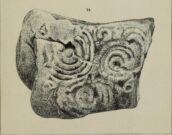Cup-and-Ring Stone (lost): OS Grid Reference – NU 053 128
Archaeology & History
This lost carving may have been brought to light as a result of field ploughing which, quite fortunately, uncovered a Bronze Age burial site with a cup-and-ring stone therein. It was reported by the regional historian David Dixon (1895) in his classic work on this area, although his description was brief and he made no sketch of the design. He told us:
“A stone-lined grave or cist, similar to that discovered at Mile, was found several years ago on Mountain Farm, in or near to which was a sandstone slab, covered with a fine example of the incised circles, such as are found in the rocks at Routin Lynn, Bewick Hill, Chatton Law and Lordenshaws Camp.”
These other petroglyphs he mentions are bloody impressive! Sadly they’re not yet on TNA. (site profiles required of them are considerable in size – if anyone would like to write them 😉 )
References:
- Beckensall, Stan, Northumberland’s Prehistoric Rock Carvings – A Mystery Explained, Pendulum: Rothbury 1983.
- Dixon, David D., Whittingham Vale, Northumberland, Robert Redpath: Newcastle-upon-Tyne 1895.
© Paul Bennett, The Northern Antiquarian

